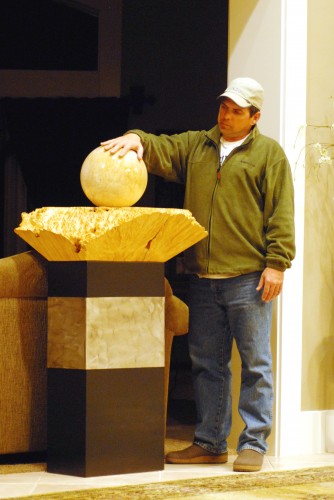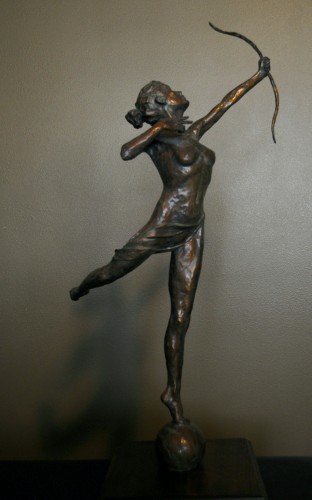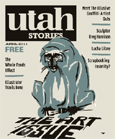by Paige Wiren
Don’t you get bored always doing the same thing? Kreg Harrison is a successful Utah sculptor who demonstrates that changing the game, the style or genre is possible with enough passion and talent.
Don’t try and compartmentalize this man or his art. Just when you think you’ve pinpointed his categorical style or subject matter, he’ll be heading down the creative path towards a new adventure. “I just have more ideas than I have time,” says the inventive Utah artist, “and I don’t listen to what other people do or say.” 
If celebrated bronze sculptor Kreg Harrison had chosen to live a life of convention, he certainly could have nurtured his once corporate career and been conventionally successful. But if he had, then this ardent Westerner would not have been invited to the world’s largest shooting, hunting and outdoor trade show where he met the Wall Street journalist who featured Kreg’s work in a front page, career-changing article. Nor would he have attended the Grand National and World Champion Morgan Horse Show which provided him the exposure to start sculpting champion horses. Would he have entertained sameness, Kreg would not have traveled to Monaco and sat on the track infield sculpting world class athletes engaged in competition. “Through sculpting I have been invited to major events, had experiences, and met all kinds of people—Hollywood people, athletes, business people. Last year I got to meet President Bush.” But Kreg isn’t boasting when he matter-of-factly lists the connections he’s made through his work. It’s what has happened as a result of focusing on that which is meaningful to him and expressing those values. Through sculpting, Kreg has intensely labored to develop his eye, his technique, and to earn the prestige he’s secured in the art world.
“I told myself that if I was going to do this, I need to be an expert,” a commitment Kreg takes very seriously and which has manifested in his possessing detailed knowledge of a myriad of different breeds of dogs and horses, species of game, fish and birds; a penetrating understanding of human anatomy and movement, and a profound appreciation of shape and form. “All my research,” the Utah native explains, “helps me capture the feeling of the subject.” Being an expert means not only studying the technique of the medium, but also becoming experientially intimate with the subjects he sculpts, so Kreg deeply examines his subjects in addition to placing himself in the context in which wildlife, animals and people engage in their activities .
.
“I believe in traditional training, in honoring the tradition of the masters who sculpted from life,” which means also that he regards art rendered from a photo or picture as weak in that the final product isn’t “real.” “It’s got to be live,” he asserts. Live means that to sculpt sportsmen he’s plied rivers with fishermen and hung out in duck blinds tracking wild fowl. Live means that he’s flown to other parts of the country to reside with a dog he’s been commissioned to fashion into bronze. To sculpt athletes from life Kreg has sat at the edge of the long jump pit with his wire, tinfoil and clay, and lay in front of a professional golfer driving high velocity shots over his head in order to understand the movement of the swing from a head-on perspective. For a commissioned seascape, Kreg had a bat ray express shipped to his home so he could accurately portray the animal, in addition to studying loggerhead turtle skulls and carapaces to depict their exact detail.
But the anatomical detail is not the essence of Kreg’s work. “Movement is my primary interest,” he identifies, “creating the illusion of movement in a static form. And it’s about capturing the nuances in balance, weight and gravity.” One well-known collector has said of Kreg’s trout sculpture titled Release that Harrison managed to capture “the exact nanosecond it occurred.”
Movement is the common thread in both his representational and non-representational pieces, because yes, just when the art world wanted to comfortably tag Kreg Harrison as a figure sculptor, he’s decided to embark on a “departure from the norm” and create sculptures using the bristlecone pine, the world’s oldest living organism, as his subject.
“This may just be one of the most important things I do,” Kreg says of the creative venture. “These trees are thousands of years old, and I think they have something they can teach us about life.” The sculptural output will be simple, non-representational forms that capture “the shapes, within shapes, within shapes. That’s the best way I can put it,” Kreg describes. The project’s theme will express his favorite Leonardo da Vinci quote that, “Simplicity is the ultimate sophistication.” He will establish a rustic base camp in southern Utah, and each day Kreg will traverse extremely rugged terrain using pack mules to haul sculpting tools to remote tree locations where the discerning artist will “look for beauty marks” in the bristlecones’ ancient and weathered forms that he will then recreate in clay. Kreg hopes that the project will bring attention to the importance of the trees’ place in the history of nature and mankind. “I’m not an activist, but I think there’s something deeply moving about the longevity of the bristlecone pine, what it has endured and how it has persisted.”
In speaking with this intent and focused sculptor you hear that he is not only interesting, but also interested. Intuition and passion have kept him moving in different subject directions though all his work is motivated by the same theme of capturing movement. His curiosity and appetite for knowledge have enriched his life and his work, and yet, Kreg concludes, “I still feel like I have so much more to learn.” §
Have the issue delivered to your home for just $3.80 (including tax and delivery).

